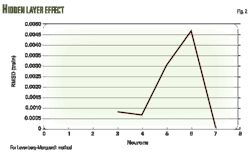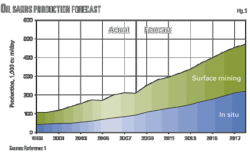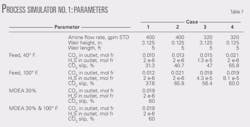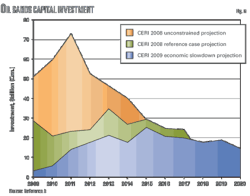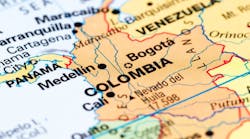Based on a presentation to SPE EUROPEC/EAGE Annual Conference and Exhibition, Amsterdam, June 8-11, 2009.
Installation of electric submersible pumps in a field in Suriname proved effective in increasing fluid extraction rates that led to higher oil production and producible reserves, even though wells may have experienced early water breakthroughs.
Staatsolie Maatschappij Suriname NV operates the field in which wells produce heavy 16° gravity oil. The wells are in shallow, high permeability, low-dipping, and very unconsolidated reservoirs that experienced early water breakthrough, short-circuiting significant reserve potential.
The vertical, openhole gravel pack completions produced water-free at 150-300 bo/d for a few months and then plummeted to 25-50 bo/d when water broke through.
Progressing cavity pumps (PCPs) were the primary artificial lift method in the 5.5-in. casing completions.
The company first attempted to install high-volume PCPs to reduce the flowing bottomhole pressure (FBHP) to restore some lost oil production after water breakthrough. Fluid withdrawal rates increased to ±700 b/d from ±350 b/d with no significant change in fluid level, water cut, or oil production.
At second attempt with an electrical submersible pump (ESP) did reduce the FBHP and increased oil production. Fluid withdrawal rates increased to ±2,200 b/d and reduced FBHP by about 100 psi.
The ESPs realized sustained oil production increases of between 100% and 400%. Water cuts increased by no more than 3%. Dynamic fluid levels in surrounding wells showed a temporary reduction, but increased and stabilized at original levels after 2-3 months, indicating a very active edge-water drive mechanism.
The company plans to add infill wells with 7-in. production casing to accommodate larger volume ESPs. It also has not observed any sand production to date, indicating no deterioration of the gravel pack at these elevated extraction rates.
At prevailing oil prices, the project recovered the investment within 4 months.
Suriname operations
The first oil discovery in Suriname was in 1964. Establishment of state oil company of Suriname (Staatsolie Maatschappij Suriname NV) in 1980 led to the drilling of the first test well in 1981, which proved the producibility of the field.1
Full-scale development started in November 1982 in Tambaredjo field when five wells produced 250 bo/d.
As field development moved further north, the terrain gradually changed from partial swamp to full-scale swamp. Location preparation, interconnecting roads, and facility foundations all required land fill, driving up infrastructural costs.
In 2003, the company drilled appraisal wells in an adjacent field, Calcutta.
In 2006, full-scale development of this field started as a wet operation, with wells drilled and completed from pontoon-based drilling equipment. Waterways connect well locations rather than roadways. All pipelines, electric poles, metering, and collection facilities, however, are on landfill dikes.
As of December 2008, both fields produced an average 16,000 bo/d from 1,188 wells (Fig. 1).
The company has appraised a third field and scheduled it for full-scale development in 2010. In addition, it is investigating development strategies for several other fields to reduce infrastructural and operational costs.
Regional geology
The coastal plain of Suriname, together with that of both French Guiana and Guyana, form the onshore part of the Guyana sedimentary basin (Fig. 2).
The reservoirs are of Paleocene age and of a coastal and noncoastal depositional environment (fluvial to shore-face) leading to erratic sand development.
Oil accumulations occur mostly in stratigraphic traps. Combination traps both structural and stratigraphical, however, also are present. These sands are of fluvial-estuarine to coastal marine origin at average 900-1,200 ft depths.
The sands were deposited in a Late Cretaceous unconformity during an overall transgressive period, as multilateral and vertically stacked sand bodies.
The river channels changed their course regularly and rapidly, resulting in a random distribution of the sand bodies over large surfaces. It is therefore difficult to make accurate sand thickness predictions because the stacking pattern of the river bars occurred randomly.
The dominant seal that traps the oil is transgressive shale that overlaps in the south on the Cretaceous surface.
Tambaredjo was the first oil producing field in the relatively unexplored Suriname-Guyana basin.
Reservoir characteristics
Oil production comes from thinly bedded, very unconsolidated clastic reservoirs, with 5-50 ft thickness, 600-1,300 ft depth, and a 95° F. formation temperature. Reservoir pressures are at the hydrostatic gradient.
These reservoirs have an average 38% porosity and 25% water saturation. The oil has average in situ 500-cp viscosity and average 16° gravity. GORs average 70 scf/bbl, seldom exceeding 100 scf/bbl.2
The T-sand package consists of vertically stacked sand bodies occasionally interbedded with clay and lignites. The sand body pinches out to the south onto the Cretaceous unconformity and forms a stratigraphic trap, while to the north it dips about 2° (Fig. 3).
The oil-bearing sand thickness varies from 3 to 45 ft with a very irregular lateral sand distribution. This sand distribution pattern results in good producers (>100 bo/d) being offset at no more than 200 m away with poor producers (<20 bo/d).
The sands consist of mostly quartz (95%) and feldspar (<5%). They are very unconsolidated, fine to coarse grained, and poorly to well sorted.
The T-sand reservoirs can be divided into a lower reservoir unit, the T1 sand, middle T2 sand, and an upper T3 sand.
The T1 sand has an average 38% porosity and 7-darcy permeability. The T2 sand and T3 sands have less permeability because of increased clay content.
In the northern part of Tambaredjo, the T1 sand, which is the main producing sand, has an oil-water contact at 1,327 ft.
A combination of solution gas drive, compaction, and water drive supports the oil production in Tambaredjo. Water drive dominates in the northern production areas such as TA45 and TA46.
Reservoir pressure ranges from 400 to 600 psi, increasing as the reservoir dips towards the north.
Field development strategy
Development of Tambaredjo started in 1982 with a 200-m well spacing. The field required artificial lift from inception because the reservoirs had normal pressure,
Initially the company installed beam pumps but later replaced them with more appropriate PCPs.
More than 95% of the wells in the field are completed as vertical openhole gravel packs with 5.5-in. casing and 2.375-in. tubing (Fig. 4).
As field development moved further north, closer to the regional oil-water contact, the company encountered thicker reservoirs within the T-sand package. Initial production rates from the wells drilled in these thicker reservoirs averaged 200 bo/d as compared with the 30-40 bo/d initial rates from the early development wells to the south.
Hence, as seen at the commencement of development of the TA45, 46, and 58 areas in 1996, the field required fewer new wells to obtain appreciable production growth.
Fig. 5 shows the gamma-ray-resistivity log of a typical well in the area with a balanced bottom cement plug. Drilling and completion practices, however, had remained about the same during this period, and increased productivity primarily was because of the thicker reservoirs.
Fig. 1 shows the production history of Tambaredjo. From 2002, production decreased noticeably because several high oil-producing wells to the north watered out.
These wells continued to produce with 85-95% water cut at oil rates that averaged 25 bo/d compared with the initial 150-350 bo/d.
These early water breakthroughs caused much oil to be bypassed, and the company implemented several techniques for increasing the recovery factor.
Strategies used included:
• Producing wells at low drawdown pressures. This resulted in production rates that remained below the critical coning rate but were below the economical limit to achieve the desired rate-of-return on investment.
• Casing off the target interval and partially perforating the upper section of the oil column. This also led to production rates below the critical coning rates and below the economic level. When rates increased, water breakthrough occurred shortly afterwards due to the high vertical permeability to horizontal permeability ratio in these highly unconsolidated reservoirs.
• Gel squeezes into the wells with high water cuts. Water production decreased but also oil rates decreased proportionally.
• Installing large volume PCPs, limited by the 5.5-in. OD casing, to maximize production rates. Production rates from the largest volume pumps at the time only marginally reduced the FBHP under the high-water cut conditions.3
Despite the aforementioned strategies or combinations of them, early water breakthrough left much bypassed oil.
The sources of water being produced in these high-water cut wells was difficult to identify due to the short openhole completed intervals (10-30 ft) at the bottom of the well, and pump installations in place.
The company considered edge-water underrunning the oil leg as the primary mechanism responsible for the water breakthrough. To a lesser, but still significant extent, is the contribution of water from the underlying, relatively low-permeability Cretaceous beds across the unconformity (Fig. 4).
It decided to increase the drawdown in these wells with appropriate high-volume pumps to allow the bypassed oil to move towards the wellbore.
Due to the limited ID of the field's standard 5.5-in. casing, the company considered PCPs inadequate to achieve the required high water-cut fluid extraction rates.
Well selection
One criterion for selecting wells that could have larger pumps was their ability to produce more than 500 b/d of fluid.
The PCP with largest production volume, at that time, able to fit comfortably in 5.5-in. casing could produce 2 b/d/rpm. At the maximum recommended speed (400 rpm) and at 80% efficiency, the pump could attain maximum rates of ±650 b/d. This rate would reduce the FBHP only marginally.
Another criterion was to have an FBHP greater than 450 psi. At the minimum ESP rate of 1,500 b/d, each well would be required to deliver an additional 1,000 b/d. This only would be possible if there was sufficient reservoir pressure capacity for this extra production without pumping off the well.
A third criterion was to have a water cut between 90 and 96%. Wells with FBHP >450 psi and producing at rates exceeding 500 b/d were inevitably high water-cut wells (>80% water cut).
The lower limit of 90% was picked to avoid selecting well candidates for this project from the existing wells with greater oil production. The upper limit of 96% was selected, so that at the maximum designed extraction rate of 2,200 b/d, the well would produce sufficient oil production to justify the investment should the water cut increase to 98%.
A fourth criterion was for the water-oil ratio to range from 9 to 24 (90-96% water cut) and have remained stable for the last 2 years.
At water cuts >90%, small changes in water cut are visible more readily when displayed as a water-oil ratio rather than percent water cut. For example, a 95% water cut corresponds with a water-oil ratio of 19 and 96% water cut corresponds with a water oil-ratio of 24. The criterion, therefore, was that the trend of the water-oil ratio during the past 2-3 years should not be increasing significantly with time.
A fifth criterion was that the well's productivity index (PI) was greater than 5. A 200-psi pump intake pressure was recommended for securing longevity in ESP operation at maximum rates. The selected wells, therefore, should have a reasonably high PI to reach the 1,500 b/d minimum before the target pump intake pressure reaches 200 psi.
For a minimum additional flow rate of 1,000 b/d, the PI required to reduce the FBHP from 450 psi to 200 psi is 4. A PI of at least 5 includes a safety margin.
The last criterion was for the wells to have a recovery greater than 20%. Even though wells with low ultimate recoveries indicate significant remaining oil in place, they also have a low recovery rate. These conditions could result from formation damage, early water break through, or high in situ oil viscosity. Wells with a high recovery percentage, on the contrary, show a high potential for favorable oil flow rates to the wellbore.
Due to the pressure support from the edge-water drive in the region under consideration, recoveries greater than 20% within 4-5 years of production were common. This confirms greater potential for higher recovery with additional drawdown than wells with lower recoveries in the same period. These lower recoveries with similar original oil in place indicate wells with formation damage or those too close to the oil-water contact.
From all the wells fitted with the large volume PCP pumps (about 20 wells), 5 wells met all the criteria listed previously. Since budget allocation limited this pilot to 3 wells, the company selected wells 9D05, 9D15, and 10A12.
ESP design considerations
The minimum intake pressure recommended for optimum performance of an ESP was 200 psi. Estimated tubinghead pressure at elevated flow conditions was 200 psi (normal THP = 100 psi).
Pump setting depth was about 1,100 ft. Tubing and casing sizes were 2.875-in. and 5.5-in., respectively. The well did not need a downhole gas-separation device because average GORs were about 50 scf/bbl.
The ESP required a variable-speed controller for minimizing the start-up surge on the already heavily loaded electrical distribution system in the field. Minimum and maximum flow rates anticipated were 1,500 b/d and 2,500 b/d, respectively.
Because no well in the field had ever been produced at rates greater than 700 b/d, it was unknown if the openhole gravel pack completion would withstand the elevated drag forces under the higher flow rates. Hence the design called for an ESP with a minimum flow rate equivalent to two times the existing maximum PCP flow rate.
At the minimum flow rate of 1,500 b/d, fluid velocity bypassing the ESP motor was more than sufficient for optimum cooling.
Performance results
Notwithstanding that this was the first experience of running ESPs for the company personnel, they completed each installation within a day-light shift and fitted out all three wells within 3 days. All wells were started at 40 hz (equivalent to 1,500 b/d) without disruption of the electrical distribution system.
Well 9D05 realized an initial 65 bo/d average rate, or a 160% increase from the preinstallation average of 25 bo/d. After 1 year, production rates are 45 bo/d, 80% above the preinstallation rate. It should be noted, however, that the FBHP also increased even though the gross fluid rate did not change (Fig. 6a). Personnel did not detect sand production in any samples taken.
Well 9D15 realized an initial average rate of 109 bo/d, or a 185% increase from the preinstallation 38 bo/d average. After 1 year, production rates are 68 bo/d or 80% greater than the preinstallation rate. Again it should be noted, however, that the FBHP also increased even though the gross fluid rate did not change (Fig. 6b). Personnel did not detect sand production in any samples taken.
Well 10A12 realized an initial average rate of 155 bo/d, or a 450% increase from the 28 bo/d preinstallation average. After 1 year, average production rate is 90 bo/d, or 320% of the preinstallation rate (Fig. 6c). As in the other two wells, personnel did not detect sand production in any samples taken.
Reserves additions
From a combined baseline production of 87 bo/d, the average combined incremental oil gain within the first 3 months combined was 240 bo/d. After 12 months production, the incremental oil gain declined to 116 bo/d.
With decline-curve analysis and extrapolating to normal abandonment, the incremental reserves gained for each well are 14,470 bbl in 9D15, 41,330 bbl in 9D05, and 67,000 bbl in 10A12.
Combined incremental reserves added are 122,800 bbl, about equivalent to 15% of original recoverable reserves determined from decline curve analysis.
Economics
All three wells had identical 35 hp, 48-stage ESPs, each fitted with variable-speed controllers on surface. The cost for all three ESP systems was about $350,000, including equipment and services.
Accounting for water treatment costs, incremental operating expenses from additional power requirements, and oil decline rates of 50%, 40%, 30%, and 20% in subsequent years, the project net present value was $1.68 million with an internal rate-of-return of 310%. The calculation used a conservative $35/bbl oil price.
For a low-tier operation, these are excellent economic returns.
Observations
Despite the average 350% increase in gross fluid production, water cut only marginally increased, not more than 3%. This resulted in the attractive oil production increases realized. To mid 2009, the wells have produced a combined incremental 40,500 bbl of oil.
Except for well 10A12, initial decreases in FBHP after ESP start-up was short-lived, apparently due to the strong pressure support at the water source.
The openhole gravel-pack completions withstood the higher drag forces at the higher production rates much better than expected.
The PI's observed at the increased drawdown indicate significant potential for further oil gains.
The company will have to consider water separation, treatment, and disposal costs if it converts many more wells to ESP production at higher rates.
Since start-up, the ESP installations have not experienced a mechanical or electrical problem.
Well 9D10, the well directly between 9D05 and 9D15, showed negligible response to the increased drawdown in the adjacent wells except for a marginal reduction in FBHP.
Project economics show a payback period of 4 months with a favorable rate-of-return of 310% and net present value of $1.68 million.
Acknowledgments
The authors thank the Staatsolie board of executive directors and their management team for their support and permission to publish this article. Contributions from the Calcutta asset team, field evaluation and development team, and the ESP project team also are appreciated.
References
1. Kartoredjo, H., et al., "Heavy Oil Field Development and Reservoir Management Challenges in Producing Onshore Shallow Reservoirs in Suriname," Paper No. SPE 104068, First International Oil Conference and Exhibition, Cancun, Mexico, Aug. 31-Sept. 2, 2006.
2. Brouwer, G.K., "Reservoir Simulation Tambaredjo Field (TA-45 & TA-58 area)," TNO Report No. B-380, Internal Report, November 2004.
3. McClung, W.J., and Johnson, J.A., "Electric Submersible Pump Application and Operation in Small Openhole Completions," Paper No. SPE 9213, SPE ATCE, Dallas, Sept 21-24, 1980.
The authors
More Oil & Gas Journal Current Issue Articles
More Oil & Gas Journal Archives Issue Articles
